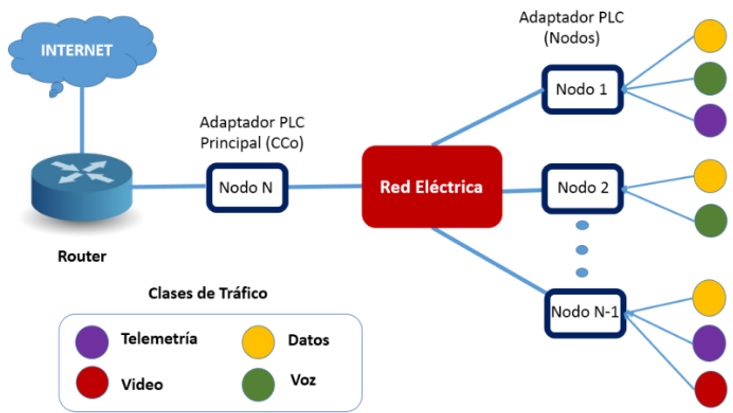Modeling of a multiservice network in HAN networks on Power Line Communications supported in Queuing Theory
Modelamiento de una red multiservicio en redes HAN sobre Power Line Communications soportado en Teoría de Colas


This work is licensed under a Creative Commons Attribution-NonCommercial-NoDerivatives 4.0 International License.
Copyright statement
The authors exclusively assign to the Universidad EIA, with the power to assign to third parties, all the exploitation rights that derive from the works that are accepted for publication in the Revista EIA, as well as in any product derived from it and, in in particular, those of reproduction, distribution, public communication (including interactive making available) and transformation (including adaptation, modification and, where appropriate, translation), for all types of exploitation (by way of example and not limitation : in paper, electronic, online, computer or audiovisual format, as well as in any other format, even for promotional or advertising purposes and / or for the production of derivative products), for a worldwide territorial scope and for the entire duration of the rights provided for in the current published text of the Intellectual Property Law. This assignment will be made by the authors without the right to any type of remuneration or compensation.
Consequently, the author may not publish or disseminate the works that are selected for publication in the Revista EIA, neither totally nor partially, nor authorize their publication to third parties, without the prior express authorization, requested and granted in writing, from the Univeridad EIA.
Show authors biography
Smart Grid is a new concept that seeks to articulate electric power and communications systems as a unified system for the optimization of energy consumption in the world, where one of the most accepted technologies for the transmission of information in residential environments is Power Line Co-communications (PLC). The objective of this article is to propose a supported model in queue theory, which allows the evaluation of multiclass traffic behavior of a HAN (Home Area Network) network under the HomePlug AV (HPAV) standard, which is one of the most important standards of PLC technology. In accordance with the results obtained, the proposed model allows estimating parameters such as arrival times, queuing times, attention times, probability of packet loss, throughput, number of packets lost, among other values related to the performance of the net. Although the model can be considered a great help for research papers related to PLC communications, it could be combined with other more advanced analysis techniques, in order to obtain deeper results and in more complex contexts.
Article visits 546 | PDF visits 334
Downloads
- Anatory, J.; Theethayi, N. (2010). Broadband Power-Line Communication Systems, London, WIT Press, pp. 120-132.
- Baskett, F.; Chandy, K. (1975). Open, closed, and mixed networks of queues with different classes of customers. Journal of the ACM, 22(2), pp. 248–260.
- Bolch, G.; Greiner, S.; Meer, H.; Trivedi, K. (2006). Queueing Networks and Markov Chains, Modeling and Performance Evaluation with Computer Science Applications, New Jersey, John Wiley & Sons, pp. 321-367.
- Buzen, J. (1971). Queueing network models of multiprogramming, Cambridge, Harvard University, pp. 150-175.
- Carvallo, A.; Cooper, J. (2011). The Advanced Smart Grid: Edge Power Driving Sustainability, London, Artech House, pp. 194-217.
- Flick, T.; Morehouse, J. (2010). Securing the Smart Grid, New Jersey, Wiley, pp. 231-250.
- Gebali, F. (2008). Analysis of Computer and Communication Networks, New York, Springer, pp. 231-257.
- Gordon, W.; Newell, G. (1967). Closed Queuing Systems with Exponential Servers. Operations Research, 15(2), pp. 254–265.
- Grimm, C.; Schluchtermann, G. (2008). IP Traffic Theory and Performance, New York, Springer-Verlag, pp. 315-347.
- Guizani, M.; Rayes, A.; Khan, B.; Al-Fuqaha, A. (2010). Network Modeling and Simulation: A Practical Perspective. New Jersey, John Wiley & Sons, pp. 187-205.
- Hock, C.; Boon, S. (2008). Queueing Modelling Fundamentals: With Applications in Communication Networks, New Jersey, John Wiley & Sons, pp. 203-221.
- Jackson, J. (1963). Jobshop-Like Queuing Systems. Management Science, 10(1), pp. 131–142.
- Czachórski T.; Gelenbe E.; Lent R. (2014). Information Sciences and Systems, Kurzyk, D.; Gawron, P., Quantum Queuing Networks Throughput Optimisation, London, Springer International Publishing, pp. 207-216.
- Latchman, H.; Srinivas, K.; Yonge, L.; Gavette, S. (2013). Homeplug AV and IEEE 1901: A Handbook for PLC Designers and Users. New Jersey, Wiley-IEEE Press, pp. 227-248.
- Mohanty, S. K.; Giri, R. K. (2014). The analysis of Broadband Communication over indoor Powerline channel. International Conference on Communications and Signal Processing (ICCSP), Melmaruvathur, India, pp. 1293–1299, https://doi.org/10.1109/ICCSP.2014.6950059
- Pancaldi, F.; Gianaroli, F.; Vitetta, G. M. (2018). Equalization of Narrowband Indoor Powerline Channels for High Data Rate OFDM Communications. IEEE Transactions on Smart Grid, 9(1), pp. 78–87, https://doi.org/10.1109/TSG.2016.2545108.
- Sancha, S.; Canete, F. J.; Diez, L.; Entrambasaguas, J. T. (2007). A Channel Simulator for Indoor Power-line Communications, IEEE International Symposium on Power Line Communications and Its Applications, Pisa, Italy, pp. 104–109, https://doi.org/10.1109/ISPLC.2007.371106
- Sanduleac, M. (2018). Unbundled Smart meters in the new smart grid era: Assessment on compatibility with European standardisation efforts and with IoT features, IEEE Mediterranean Electrotechnical Conference (MELECON), Marrakech, Morocco, pp. 35–41, https://doi.org/10.1109/MELCON.2018.8379064
- Vesga, J. C.; Sierra, J. E.; Barrera, J. A. (2018). Performance evaluation under an AFR scheme CSMA/CA for HomePlug AV supported in Bianchi’s Model. Indian Journal of Science and Technology, 11(8), pp. 1–14, https://doi.org/10.17485/ijst/2018/v11i8/117511.
- Wang, X.; Yang, Y.; Xu, M.; Lv, P. (2014). Network Virtualization for Smart Grid Communications. IEEE Systems Journal, 8(2), pp. 471–482, https://doi.org/10.1109/JSYST.2013.2260695.




